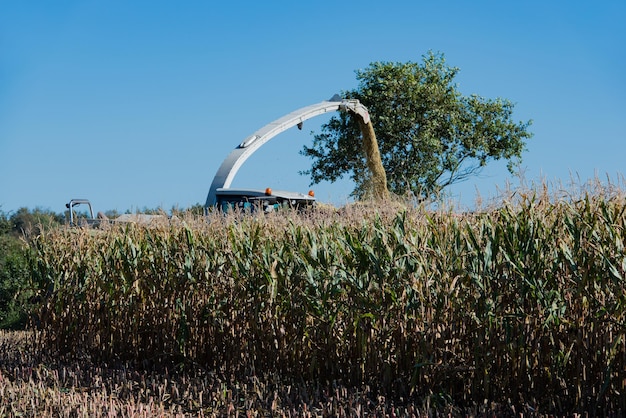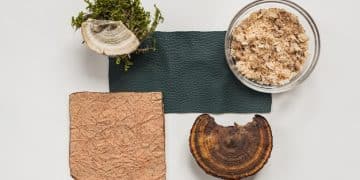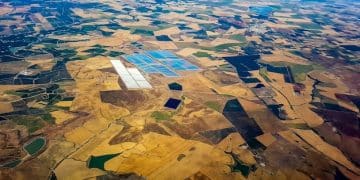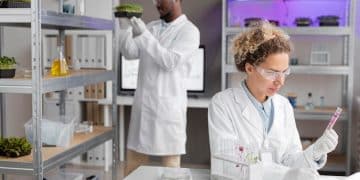Bioplastics in the US: A 2030 Outlook on Plant-Based Polymer Revolution

Bioplastics in the US are projected to experience significant growth by 2030, driven by increasing environmental concerns and technological advancements in plant-based polymer production, offering a sustainable alternative to traditional plastics.
The landscape of plastics in the United States is on the cusp of a significant transformation. By 2030, bioplastics in the US: Exploring the Potential of Plant-Based Polymers to Replace Traditional Plastics by 2030 are poised to play a much larger role in our economy and environment.
The Rise of Bioplastics: A Sustainable Solution
Bioplastics are gaining traction as a viable alternative to traditional, petroleum-based plastics. As concerns about plastic pollution and its environmental impact intensify, the demand for sustainable alternatives is soaring. Bioplastics, derived from renewable resources, offer a promising pathway toward a more circular and eco-friendly economy.
This section delves into the fundamental characteristics of bioplastics, differentiating them from conventional plastics and highlighting their unique properties. We will examine the various types of bioplastics, including those made from starch, cellulose, and polylactic acid (PLA), and explore their respective strengths and weaknesses.

What are Bioplastics?
Bioplastics are a family of plastics that are either bio-based, biodegradable, or both. Bio-based plastics are made from renewable resources, such as corn starch, sugarcane, or vegetable oils. Biodegradable plastics can break down into natural substances, such as carbon dioxide, water, and biomass, under specific conditions. It’s important to note that not all bio-based plastics are biodegradable, and not all biodegradable plastics are bio-based.
Types of Bioplastics
Several types of bioplastics are currently available, each with its unique properties and applications. Some of the most common types include:
- Starch-based plastics: Made from corn starch or other plant-based starches, these plastics are commonly used in packaging and disposable cutlery.
- Cellulose-based plastics: Derived from cellulose, the main structural component of plants, these plastics are used in films, coatings, and fibers.
- Polylactic acid (PLA): Produced from fermented plant starch, PLA is a versatile bioplastic used in packaging, textiles, and medical implants.
- Polyhydroxyalkanoates (PHAs): Produced by microorganisms, PHAs are biodegradable and biocompatible plastics with a wide range of potential applications.
In summary, the emergence of bioplastics signifies a pivotal shift towards sustainable material consumption, offering a tangible solution to mitigate the environmental impact of conventional plastics.
The US Bioplastics Market: Current Status and Future Projections
The bioplastics market in the US is experiencing robust growth, driven by increased consumer awareness, stricter environmental regulations, and advancements in bioplastics technology. While still a small fraction of the overall plastics market, bioplastics are steadily gaining market share across various sectors.
This section investigates the current state of the bioplastics market in the US, analyzing key market trends, growth drivers, and challenges. We will explore the market size, segmentation by application, and major industry players. Additionally, we will delve into future market projections, examining potential growth scenarios and factors that could influence market dynamics.
Market Size and Segmentation
The US bioplastics market is segmented by application, including packaging, agriculture, textiles, automotive, and consumer goods. Packaging currently dominates the market, driven by the demand for sustainable packaging solutions in the food and beverage industry. Other significant application areas include agriculture, where bioplastics are used in mulch films and seed coatings, and textiles, where bioplastics are used in apparel and home furnishings.
Key Market Trends and Drivers
Several factors are driving the growth of the bioplastics market in the US, including:
- Increasing consumer awareness: Consumers are becoming more aware of the environmental impact of plastics and are actively seeking sustainable alternatives.
- Stricter environmental regulations: Government regulations aimed at reducing plastic waste and promoting recycling are driving demand for bioplastics.
- Technological advancements: Ongoing research and development efforts are leading to improved bioplastics performance and reduced production costs.
- Corporate sustainability initiatives: Many companies are implementing sustainability initiatives that include the use of bioplastics in their products and packaging.

The US bioplastics market is poised for continued growth in the coming years, driven by increasing demand for sustainable solutions and ongoing innovation in bioplastics technology.
Government Regulations and Incentives for Bioplastics
Government regulations and incentives play a crucial role in shaping the bioplastics market in the US. Policies that promote the use of bioplastics, reduce plastic waste, and support research and development can significantly accelerate the adoption of these sustainable materials.
This sections examines the existing government regulations and incentives that impact the bioplastics market in the US. We will analyze policies at the federal, state, and local levels, including mandates for the use of recycled content, bans on single-use plastics, and tax incentives for bioplastics production. Additionally, we will assess the effectiveness of these policies and identify opportunities for further government action.
Federal Policies
Several federal policies impact the bioplastics market in the US, including:
- The Farm Bill: Provides funding for research and development of bio-based products, including bioplastics.
- The Federal Acquisition Regulation (FAR): Encourages the use of bio-based products in federal procurement.
- The Environmental Protection Agency (EPA) programs: Promote waste reduction and recycling, indirectly supporting the bioplastics market.
State and Local Policies
Many states and local governments have implemented policies to reduce plastic waste and promote the use of sustainable alternatives. These policies include:
- Bans on single-use plastic bags and straws: Encourage the use of reusable or compostable alternatives.
- Mandates for recycled content: Require manufacturers to use a certain percentage of recycled content in their products.
- Tax incentives for bioplastics production: Attract bioplastics manufacturers to the state or locality.
Government policies play a vital role in fostering a favorable environment for bioplastics adoption in the US.
Technological Advancements in Bioplastics Production
Technological advancements are essential for improving the performance, reducing the cost, and expanding the applications of bioplastics. Ongoing research and development efforts are focused on developing new bio-based polymers, optimizing production processes, and enhancing the properties of existing bioplastics.
This section explores the latest technological advancements in bioplastics production, examining innovations in feedstock sourcing, polymer synthesis, and processing techniques. We will delve into emerging technologies, such as metabolic engineering and synthetic biology, which hold the potential to revolutionize bioplastics production. Additionally, we will assess the impact of these advancements on the competitiveness and sustainability of bioplastics.
Researchers are exploring a wide range of feedstocks for bioplastics production, including:
Advancements in production processes are also contributing to the growth of the bioplastics market.
New Feedstock Sources
- Algae: Algae can be used to produce a variety of bioplastics, including PHAs and polylactic acid (PLA).
- Cellulosic biomass: Agricultural residues, such as corn stover and wheat straw, can be used to produce cellulose-based plastics.
- Carbon dioxide: Captured carbon dioxide can be used as a feedstock for bioplastics production, reducing greenhouse gas emissions.
Improved Production Processes
- Metabolic engineering: Optimizing microorganisms to produce bioplastics more efficiently.
- Enzyme engineering: Developing enzymes that can break down biomass into sugars for bioplastics production.
- 3D printing: Using 3D printing to create customized bioplastic products with complex geometries.
These technological advancements are paving the way for more sustainable and cost-effective bioplastics production.
Challenges and Opportunities for Bioplastics Adoption
Despite the promising potential of bioplastics, several challenges hinder their widespread adoption. These challenges include higher production costs, limited performance characteristics, and a lack of infrastructure for bioplastics recycling and composting.
This section identifies the key challenges and opportunities for bioplastics adoption in the US. We will analyze the economic, technical, and environmental barriers to bioplastics commercialization. Additionally, we will explore strategies for addressing these challenges, such as reducing production costs, improving bioplastics performance, and developing robust end-of-life management systems.
Economic Challenges
The higher production costs of bioplastics compared to conventional plastics remain a significant barrier to adoption. These higher costs are due to:
- Higher feedstock costs: Bio-based feedstocks can be more expensive than petroleum-based feedstocks.
- Lower production volumes: Bioplastics are produced in smaller volumes than conventional plastics, leading to higher unit costs.
- Lack of economies of scale: The bioplastics industry is still relatively young, and economies of scale have not yet been fully realized.
Technical Challenges
Bioplastics often have limited performance characteristics compared to conventional plastics, such as:
- Lower heat resistance: Some bioplastics cannot withstand high temperatures, limiting their use in certain applications.
- Lower strength and durability: Some bioplastics are not as strong or durable as conventional plastics, limiting their use in demanding applications.
There are many opportunities for bioplastics adoption in the US, driven by increasing consumer demand for sustainable products and growing government support for bioplastics.
The Future of Bioplastics in the US: A 2030 Vision
By 2030, bioplastics are expected to play a significant role in the US plastics market, driven by increasing environmental concerns, stricter regulations, and technological advancements. The future of bioplastics in the US hinges on overcoming existing challenges and capitalizing on emerging opportunities.
This section presents a vision for the future of bioplastics in the US by 2030. We will explore potential scenarios for market growth, technological development, and policy changes. Additionally, we will identify the key factors that will shape the bioplastics landscape in the coming years.
In conclusion, bioplastics hold immense promise as a sustainable alternative to traditional plastics in the US. While challenges remain, ongoing innovation, supportive government policies, and increasing consumer demand are paving the way for a brighter future for bioplastics. By 2030, bioplastics have the potential to significantly reduce our reliance on fossil fuels, minimize plastic pollution, and contribute to a more circular and sustainable economy.
| Key Point | Brief Description |
|---|---|
| 🌱 Bioplastic Definition | Plastics that are bio-based, biodegradable, or both, from renewable resources. |
| 📈 US Market Growth | Driven by consumer awareness, regulations, and technological advances. |
| 🔬 Tech Advancements | New feedstocks, improved processes, and metabolic engineering. |
| 🌍 Challenges & Opportunities | Economic and technical hurdles, but also increasing demand and policy support. |
FAQ Section
▼
The primary feedstocks include corn starch, sugarcane, cellulose, and algae. These renewable resources are used in various bioplastic production processes, offering a sustainable alternative to petroleum.
▼
No, not all bioplastics are biodegradable. Some are bio-based, meaning they are made from renewable resources, but they may not break down naturally. Others are both bio-based and biodegradable.
▼
Key sectors include packaging, agriculture, textiles, automotive, and consumer goods. Packaging is dominating due to the demand for sustainable packaging solutions in the food and beverage industry.
▼
Federal policies like the Farm Bill, FAR, and EPA programs support bioplastics. Additionally, many state and local governments implement policies to reduce plastic waste and promote sustainable alternatives.
▼
Bioplastics are expected to play a significant role in the US plastics market by 2030, driven by environmental concerns, regulations, and technological advancements, which enhance adoption and reduce reliance on fossil fuels.
Conclusion
The journey of bioplastics in the US towards 2030 is marked by both promise and challenges. As environmental awareness grows and technology advances, these plant-based polymers are set to revolutionize industries. Overcoming hurdles like cost and performance will pave the way for a more sustainable, eco-friendly future, making bioplastics a key player in reducing environmental impact.





